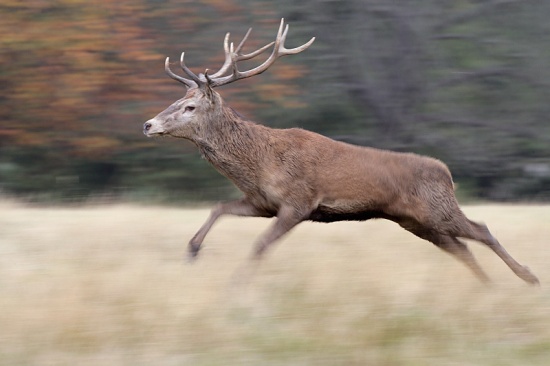Overview
Richmond Park is the largest of London's Royal Parks (950 hectares) and a NNR (National Nature Reserve), SSSI and SAC (Special area of conservation). It is famous for its herds of Red and Fallow Deer. The Park is dominated by ancient oak woodlands, acid grassland and some extensive areas of bracken. The Pen Ponds are located in the centre of the Park. The Upper Pond has a small reedbed. There are several smaller ponds elsewhere in the Park and Beverley Brook runs through the north-eastern part of the Park. Around 115-120 species are recorded annually with more than 55 breeding.
It can be overrun with visitors but early mornings, evenings, weekdays and days of bad weather are fairly quiet.
Birds
Notable Species
Woodland birds include all 3 woodpeckers (the Park may be one of the best sites in London for Lesser Spotted Woodpecker with up to 5 breeding pairs), Stock Dove, Tawny Owl, Blackcap, Common Chiffchaff, a few Garden Warblers, Nuthatch and Treecreeper. Little Owls are widespread on the fringes of woodland. Kestrels and Sparrowhawk are resident. Hobby may be seen in summer. Jackdaws and Ring-necked Parakeets are the two most obvious species in the Park.
Skylarks breed in the grassland. Reed Buntings breed in bracken areas close to the Pen Ponds. Meadow Pipit and Common Stonechat recently ceased to breed (although a pair of Stonechats returned to breed in 2012) but still can be seen at other times of year. Whitethroats breed in areas of scrub.
The Pen Ponds hold the commoner wildfowl and can host good numbers of Eurasian Wigeon. Common Terns now breed on a raft. Egyptian Goose and Mandarin Duck have significant populations in the Park. The reedbed has summering Reed Warblers and resident Water Rail although the latter are hardly ever seen. Waders are rare with only the odd Snipe being seen regularly and the occasional Common Sandpiper. Beverley Brook holds Kingfisher and Grey Wagtail.
On passage the commoner warblers occur as do Hirundines, Wheatear, Whinchat, Fieldfare, Spotted Flycatcher and the occasional Ring Ouzel and Common Redstart. The larger raptors, such as Common Buzzard and Red Kite are sometimes seen. Two of the best areas for migrants are the Hawthorn Valley and the Bog, both situated near Holly Lodge in the north of the Park. In winter Eurasian Woodcock can be seen leaving their woodland roost sites and flocks of Redwing, Lesser Redpoll and Siskin may be encountered. In recent winters Dartford Warblers have been found in bracken, usually in the company of Stonechats but have not been seen since the recent hard winters. Update: present winter 2014/5.
Rarities
The most productive time for the rarity hunter is during the spring and autumn passage periods. Rarities include Little Bittern, Bee-eater, Eurasian Hoopoe, Eurasian Wryneck, Alpine Swift, Barred Warbler, Woodchat, Red-backed and Great Grey Shrikes, Golden Oriole and Ortolan Bunting.
Check-list
Birds you can see here include:
Great Crested Grebe, Great Cormorant, Grey Heron, Mandarin Duck, Eurasian Wigeon, Gadwall, Mallard, Common Pochard, Tufted Duck,Egyptian Goose, Eurasian Sparrowhawk, Common Kestrel, Northern Hobby, Common Moorhen, Eurasian Coot, Common Sandpiper, Black-headed Gull, Herring Gull, Common Tern, Stock Dove, Feral Pigeon, Common Woodpigeon, Ring-necked Parakeet, Common Cuckoo, Little Owl, Tawny Owl, Common Swift, Green Woodpecker, Great Spotted Woodpecker, Lesser Spotted Woodpecker, Eurasian Skylark, Sand Martin, Barn Swallow, Northern House Martin, Meadow Pipit, Pied Wagtail, Grey Wagtail, Common Wren, Dunnock, Eurasian Robin, Whinchat, European Stonechat, Northern Wheatear, Eurasian Blackbird, Fieldfare, Song Thrush, Redwing, Mistle Thrush, Common Reed Warbler, Common Whitethroat, Garden Warbler, Blackcap, Common Chiffchaff, Willow Warbler, Goldcrest, Long-tailed Tit, Coal Tit, Blue Tit, Great Tit, Eurasian Nuthatch, Common Treecreeper, Common Jay, Common Magpie, Carrion Crow, Eurasian Jackdaw, Common Starling, Chaffinch, European Greenfinch, European Goldfinch, Eurasian Siskin, Lesser Redpoll, Reed Bunting
Other Wildlife
Grey Squirrel Sciurus carolinensis is the most commonly seen mammal but deer are present in good numbers and include both Red Deer Cervus elaphus and Fallow Deer Cervus dama. Other mammals include Badger, Fox, Mole Talpa europaea, Rabbit Oryctolagus cuniculus, various bats, shrews, voles and Wood Mouse Apodemus sylvaticus.
Site Information
The park is open from 07.00 (07.30 in winter) until dusk.
History and Use
Various sports and activities, including horse riding and fishing.
One of the oldest of the Royal Parks.
Areas of Interest
In the centre of Richmond Park are Pen Ponds with a small reedbed and some damp woodland.
Access and Facilities
Richmond Park can be reached from central London on the A4 to Hammersmith and then the A316 to Richmond and from there the park is signposted.
Richmond also has an underground station on the District Line.
External Links
Content and images originally posted by Steve




